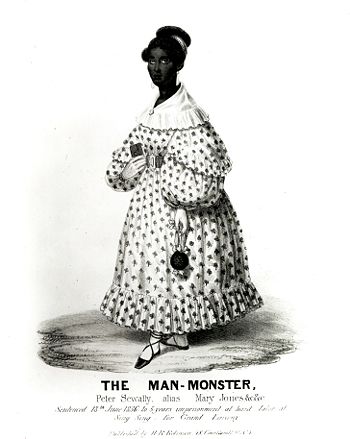Peter Sewally - Mary Jones, June 11, 1836
The "Man Monster"
Adapted, with permission, from Jonathan Ned Katz's Love Stories: Sex Between Men Before Homosexuality.[1]
About ten o’clock on the night of Tuesday, June 11, 1836, in New York City, a master mason named Robert Haslem, a white man was walking home after a liaison with a woman he had picked up earlier that evening, as the New York Herald later reported.
On Bleecker Street, Haslem met a black woman, Mary Jones, dressed "elegantly and in perfect style," with white earrings and a gilt comb in her hair.<N18> The Herald's rival, the New York Sun, added that Mary Jones also went by the names "Miss Ophelia:' "Miss June:' and "Eliza Smith."
Haslem or Jones initiated a conversation-the newspapers differed. Haslem then asked Jones, "Where are you going my pretty maid?" and volunteered to go with her.
Before they set off "on this tour of pleasure," said the Herald,) she "lovingly threw her arms around him and strained him to her heart." Then, "these delicate preludes having ended, they proceeded onwards, until they arrived at an alley in Greene Street [known then as a site of prostitution], which having entered *****" Here, a se-ries of asterisks in the Herald's report suggest, as clearly as the missing words, a sexual act.
Haslem and Jones "had some further conversation" in an alley, said the more reticent Sun, "where the prisoner again had his arms about complainant."<N19> Afterward, on his way home, according to the papers, Haslem discovered that his wallet and ninety-nine dollars were missing. In their place he unaccountably found the wallet of a man he did not know, with a bank order for the then large sum of $200.
Haslem sought out the man who, at first, denied ownership of the wallet, but then admitted he had had his pocket picked the previous evening, under the same circumstances as Haslem. He had been "too wise," how-ever, "to expose himself" by reporting the theft to the police.
Next morning the determined Haslem confessed his story to a Constable Bowyer who, that evening, set out to find Mary Jones. Around midnight, on the Bowery, Bowyer passed a black woman and, according to the Herald, "thinking that this might be the one he sought" (and assuming the right to his gaze), looked at her face and "made up his mind that he was right."
"Where are you going at this time of night?" he asked. "I am going home, will you go too?" she answered. He agreed, and "she conducted him to her house in Greene Street, and invited him in."
He declined, "with great regret," but later walked her to an alley where she asked him, as the Herald put it, "to reenact the scene of the previous evening" with Haslem. She then "proceeded to be very affectionate:' and Bowyer arrested her.
"A tussle ensued:' the Sun reported, during which the prisoner allegedly took two wallets from her bosom and threw them away. One turned out to be Haslem's. On the way to the watch house, Jones allegedly tried to ditch another wallet but was caught. With Jones locked up, the constable took her key, searched her apartment, and found, allegedly, a number of other wallets.
A Discovery
Constable Bowyer then searched Mary Jones and, said the Sun, "for the first time discovered that he [Jones] was a man." Until that time, said the paper, Bowyer had had no doubts about Jones's sex.
The papers suggested that the complainant, Haslem, had not reported, or had not known that Jones was a man.<NOTE 20> Can we believe this? Might Haslem have recognized a cross-dressing prostitute but not cared about his sex? Or, could Haslem have sought sex with a cross-dressed woman-man? The known documents do not tell us.
"Bowyer also discovered," said the Sun,', that the prisoner, "to sustain his pretension, and impose upon men"-- here seventeen words in clumsy Latin complete the sentence. Translated, the phrase says that the woman impersonator "had been fitted with a piece of cow [leather?] pierced and opened like a woman's womb ["vagina" is the intended word], held up by a girdle."<NOTE 21> Educated, Latin-reading, upper-class men could apparently contemplate such details without harm; women and lower-class persons of either sex could not.
The Trial
On June 16, five days after Haslem's fateful meeting with Jones, the prisoner, charged with grand larceny, was tried for stealing Haslem's wallet and money. He was not prosecuted for "sodomy," apparently because he had not participated in anal intercourse.
The accused appeared in court, the Sun reported, "neatly dressed in female attire, and his head covered with a female wig," seemingly his outfit when arrested. Did the prisoner choose to be tried in female clothes? His costume was probably the court's doing.
The spectacle of a cross-dressed black man, and of the victimized Haslem, the Herald reported, provided "the greatest merriment in the court, and his Honor the Recorder, the sedate grave Recorder laughed till he cried." During the trial, the Sun reported, someone in the audience, "seated behind the prisoner's box, snatched the flowing wig from the head of the prisoner." This "excited a tremendous roar of laughter throughout the room."
Do not we sense here a note of hysteria, suggesting submerged anxi-eties about sexuality, gender, and race, each highly charged emotionally and politically? Then, as now, the combination of eros, gender, and race made an explosive mix.
A legal transcript of the prisoner's examination recorded the words he uttered in his own defense; a brief, rare, first-person voice from America's
- ↑ Jonathan Ned Katz, Love Stories: Sex Between Men Before Homosexuality (Chicago: University of Chicago Press, 2001), pp. 80-87. Copyright by Jonathan Ned Katz. Not to be reproduced for commercial purposes without permission from Katz.
